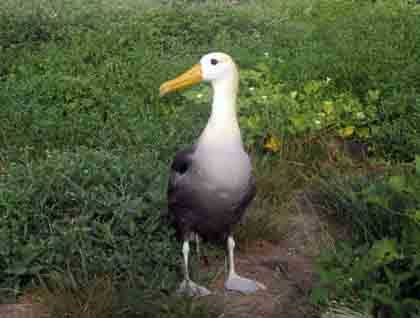Located in the extreme southeast of the archipelago and considered the oldest island, Española offers a great number of endemic species and has exuberant life everywhere. From a distance Española looked dry, with no highlands as compared with the island we visited yesterday, San Cristobal.
After breakfast we started our activities, heading the Zodiacs to Gardner Islet to snorkel and discover a magical underwater world, with a great number of colorful invertebrates and fish. We observed sponges, algae, stingrays, king angel fish, sharks and many other species of tropical fish. The visibility was excellent, therefore it was easy to observe different attractions such as bonitos (tuna fish) feeding on small sardines and young sea lions making bubbles to get the attention of our guests. Along the vertical walls of the cliffs surrounding the islet we observed lava herons trying to catch some crabs, and blue-footed boobies and marine iguanas feeding on algae. Probably the most attractive was to observe one of the blue-footed boobies jumping and fishing among us; we observed its body undersea like an arrow, with a small fish caught in its beak.
After deep water activities our guests landed at Gardner Bay to visit on one of the most beautiful beaches in the world. With the white color contrasting with the black bodies of the sea lion, this place was perfect to take photos, swim, and admire the tameness of all creatures found there. Española mockingbirds, finches and baby sea lions approached us, and their fearlessness was delightful to our guests.
In the afternoon National Geographic Endeavour was repositioned to Punta Suarez. Our activities began when we landed on the small dock inhabited by many sea lions, crabs, and reddish marine iguanas, with their bodies on the black rocks, facing and adoring the sun. Walking inland the vegetation was exuberant, which is the result of the last rains. Among the bushes we observed many female marine iguanas with their dusty bodies making nests. Finally we arrived at the cliffs where Nazca and blue-footed boobies nested or carried their chicks, while in the air the huge albatross demonstrated to us the reason it is considered the largest sea bird in Galápagos.
We arrived at the blowhole, which looked spectacular with huge waves breaking against the rocks and flooding the seashore around it with white foam. We stopped for many minutes to observe this natural formation and to view some albatrosses landing and taking off from the cliffs, using the flat terrain as an airstrip.
It was late and the sun set along the west, showed us Floreana Island, our next destination during this week in paradise.







